Christian Kremp "Nocturnus 6x32"
| Dieses seltene 6x32 Monokular mit eher großem Korpus ist auf dem oberen Deckel mit "Nocturnus CKW und 6x32" gemarkt. Die Initialien CKW sind ineinander verwoben und stehen für "Christian Kremp Wetzlar", eine Werkstätte, die zuerst Musikinstrumente, zwischen 1910 und ca. 1930 auch optische Geräte und heutzutage Zahnstanden und-räder herstellt. Ob es überhaupt ein auf dem Markt erhältliches Monokular gab, ist fraglich. Nach persönlicher Kprrespondenz mit dem Urenkel Kremps vermutet er eher, dass es sich um eine Vorserienproduktion handelt. Es wiegt 302g, hat einen 57x57mm bzw. 60x60mm großes Prismengehäuse aus Aluminium mit einer Lederummantelung und eingegossener Trageriemenöse. Die Messingdeckel und -teile sind oder waren schwarz lackiert. Die Augenmuschel ist aus Bakelit und 33mm im Durchmesser, während das rechtsseitige Okular 30mm misst und einen Dioptrienausgleich von +/-5 hat. Die aufgeschraubte Objektivfassung ist 37mm im Durchmesser. Die Gesamtlänge des Glases beträgt 103-108mm. Die Bauform wirkt so gedrungen; das Monokular hat recht große Porroprismen und Streulicht im Strahlengang wird vor den Linsen durch eingeschraubte Blechtrichter verhindert. Die Deckel und ein Blendschutztrichter sind mit Teilenummern (0)89 geritzt - evtl. lässt sich daraus ein Rückschluss auf das Produktionsdatum 1921 ziehen (n. Verkaufsunterlagen von Ch. Kremp). |
This rare 6x32 monocular with a rather big body is marked "Nocturnus CKW und 6x32" on its top cover. The interwoven initials "CKW" stand for "Christian Kremp Wetzlar", a maker first of musical instruments, of optical instruments between 1910 and 1930, and producer of cogwheels and racks nowadays. Whether there was a monocular available at all is uncertain. After private correspondence with Kremp's great-grandson he rather assumes this is a pre-production model. The glass weighs 302g, it has a 57x57mm or 60x60mm prism housing made of aluminium with a cast-in strap lug, and with a leather covering. The brass covers and parts are or were painted black. The eyecup is made of Bakelite and ha s a diameter of 33mm. The right-hand sided ocular itself measures 30mm in diameter, having a dioptre scale of + to - 5. The screwed on objective frame is 37mm in diameter. The glass is 103-108mm long. The constructions looks compact. The porro prisms inside are quite big. To prevent stray light in the light path, there are funnel shaped metal tubes screwed in front of the lenses at the inside. The covers and one of the funnels have scratched-in part numbers (0)89 – probably this hints to a production date of 1921 (acc. to sale records by Ch. Kremp). |
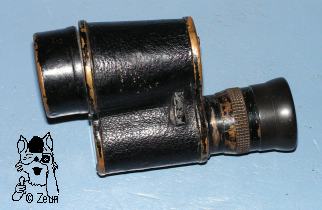
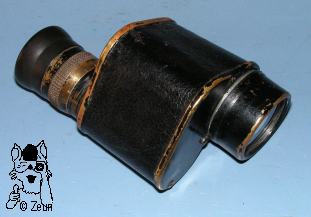
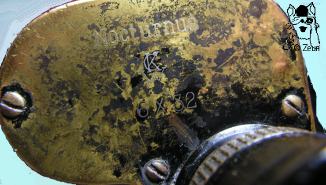
Drei Infoverweise zur Firma: Die unteren Werbeseiten beziehne sich auf das Binokular "Nocturnus". |
Here are three links conc. the maker: http://www.kremp-wetzlar.com/kgmd01.htm http://de.wikipedia.org/wiki/Christian_Kremp http://www.musoptin.com/Klemi_1362.html the advertising pages below refer to the "Nocturnus" binoculars. |
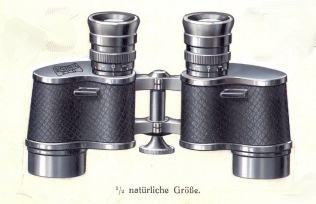
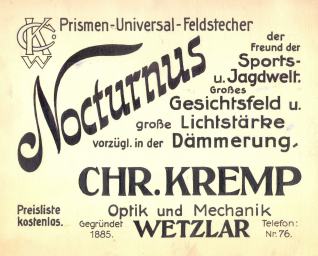
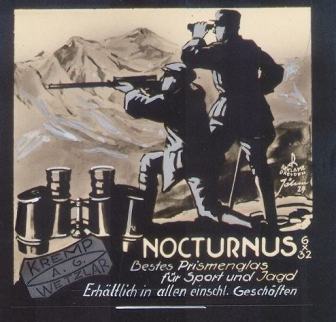
Fotos: 1-3 Zeun; 4-6 Ch. Kremp

